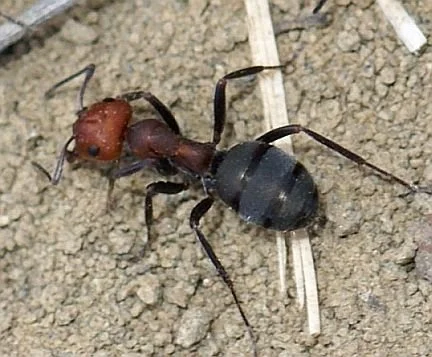Ant Control
Ants are one of the most common household pests in the world. They are found on every continent except Antarctica. There are many types of ants and controlling them requires an inspection of conducive conditions and understanding their habits. Ant control can take time to be effective and your technician can and will elaborate on the whys and wherefores of this particular pest.
-

Odorous House Ants
The odorous house ant is native to most of the entire United States ranging from Canada into Mexico. These ants feed on many different items including most items found in homes but apparently prefer to feed on those high in sugars. Outside, Tapinoma sessile will feed on honeydew excreted by aphids and on nectar from flowers and buds
Workers are 1/16 to 1/8 inch (2.4-3.3 mm) long and monomorphic (all members are about the same size). The body is uniform in color from brown to black, antenna is 12-segmented without a club, thorax is uneven, and pedicel has one hidden node. There is no circle of hairs at the anal pore. A distinctive characteristic of this species is the rotten odor when crushed. -

Carpenter Ants
The carpenter ant is a common invader of homes in the northwestern United States. In their natural habitat, carpenter ants aid in the decomposition of dead, decaying trees. They normally nest in logs, stumps, and hollow trees. However, the large, dark-colored workers often invade homes in search of food. These ants seldom tunnel into dry, sound wood, but they may excavate moist, rotting wood and other soft materials (such as foamed plastic insulation board) to make satellite nests. Rarely will the expansion of a nest into a building's wooden timbers cause structural damage. Homes built in wooded areas are especially subject to infestation.
Carpenter ants and termites are social insects that live in colonies and excavate wood. Because of this, homeowners may mistake one for the other. It is important to distinguish between the two because each requires different methods of control.
-

Pavement Ants
The pavement ant is an introduced species and is one of the most commonly encountered house-infesting ants in Pennsylvania. The ants were likely carried to the United States in the holds of merchant vessels during the 1700s to 1800s. These ships were filled with soil from Europe to provide ballast on the trip to the States. Once in port, the soil was removed, and goods were loaded on the ships to carry back across the Atlantic.The pavement ant workers are about 2.5-4 mm long and vary in color from dark brown to black, with parallel furrows or lines on the head and thorax. The pedicel, which connects the thorax and abdomen, has two segments. The posterior/dorsal thorax has two spines that project upward to the rear, and they carry a stinger in the last abdominal segment.
The swarmers or reproductive ants are winged, about twice the size of the workers, and also have a furrowed head and thorax. The spines are evident on the females but absent on the males. -

Thatching Ants
Thatching ants are also popularly known as mound ants as they are notorious for building mounds composed of various yard debris such as sticks, stems, pine needles and more. The mounds they construct are visibly distinguishable and can cause an eyesore for homeowners dealing with an infestation. When they aren’t nesting in the mounds they have constructed, you can typically find them living in decomposing trees or soil .Overall, Thatching ants have a positive effect on the ecosystem as they are efficient at eliminating harmful insects. However, when Thatching ants infest homes and yards they can cause problems for homeowners. They are aggressive ants that deliver a painful bite. The Thatching ant bite can cause blisters to humans and household pets as they tend to spray the bitten area with formic acid. Furthermore, they also destroy the buds of fruit trees and devastate plants as well as tree seedlings.

